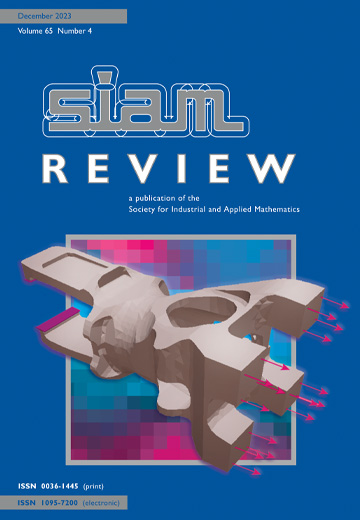SIGEST
IF 6.1
1区 数学
Q1 MATHEMATICS, APPLIED
引用次数: 0
Abstract
SIAM Review, Volume 65, Issue 4, Page 1107-1107, November 2023.The SIGEST article in this issue is “Are Adaptive Galerkin Schemes Dissipative?” by Rodrigo M. Pereira, Natacha Nguyen van yen, Kai Schneider, and Marie Farge. “Although this may seem a paradox, all exact science is dominated by the idea of approximation.” With this quote from Bertrand Russell from 1931 commences this issue's SIGEST article. Indeed, approximation is at the core of mathematics associated to studying partial differential equations (PDEs) with the idea of approximating the solution to the continuous equation with a finite number of modes. The finite element method for PDEs is a prime exemplar of such an approximation, and much research has been dedicated to getting this approximation as accurate and computationally efficient as possible. In this context, adaptive finite element methods and especially Galerkin methods are often the method of choice. Here, typically, when used for solving evolutionary PDEs the number of modes in the Galerkin scheme is fixed over time. In this article, the authors consider adaptive Galerkin schemes in which the number of modes can change over time, and they introduce a mathematical framework for studying evolutionary PDEs discretized with these schemes. In particular, they show that the associated projection operators, i.e., the operators that project the continuous solution onto the finite-dimensional finite element spaces, are discontinuous and introduce energy dissipation. That this is a significant result is demonstrated by studying adaptive Galerkin schemes for the time evolution of the inviscid Burgers equation in 1D and the incompressible Euler equations in 2D and 3D. They show that adaptive wavelet schemes regularize the solution of the Galerkin truncated equations and yield convergence towards the exact dissipative solution for the inviscid Burgers equation. Also for the Euler equations this regularizing effect can be numerically observed though no exact reference solutions are available in this case. This motivates, in particular, adaptive wavelet Galerkin schemes for nonlinear hyperbolic conservation laws and leave their systematic study for this class of PDEs for an interesting future work. For the SIGEST article the authors have expanded their original Multiscale Modeling & Simulation article by providing a more comprehensive discussion on adaptive Galerkin methods fit for a general mathematical audience. They have also added a new section on continuous wavelet analysis of the inviscid Burgers equation, analyzing its time evolution, and added an illustration for the development of thermal resonances in wavelet space. Overall, adaptive Galerkin methods and their mathematical properties will be of interest to a wide range of applied mathematicians who study PDE models, and also to applied analysts and numerical analysts who wish to simulate PDEs numerically.
SIGEST
SIAM评论,第65卷第4期,第1107-1107页,2023年11月。本期SIGEST的文章是Rodrigo M.Pereira、Natacha Nguyen van yen、Kai Schneider和Marie Farge的《自适应伽辽金方案是耗散的吗?》。“尽管这似乎是一个悖论,但所有精确科学都被近似的思想所支配。”引用伯特兰·罗素1931年的这句话,开始了本期SIGEST的文章。事实上,近似是研究偏微分方程(PDE)的数学核心,其思想是用有限个模式近似连续方程的解。偏微分方程的有限元方法是这种近似的一个主要例子,许多研究都致力于使这种近似尽可能准确和高效。在这种情况下,自适应有限元方法,尤其是伽辽金方法通常是首选方法。这里,通常,当用于求解进化偏微分方程时,Galerkin格式中的模式数随时间固定。在本文中,作者考虑了模式数量可以随时间变化的自适应Galerkin格式,并介绍了一个研究用这些格式离散的进化偏微分方程的数学框架。特别地,他们表明,相关的投影算子,即将连续解投影到有限维有限元空间上的算子,是不连续的,并引入能量耗散。通过研究一维无粘性Burgers方程和二维和三维不可压缩Euler方程的自适应Galerkin格式,证明了这是一个重要的结果。他们证明了自适应小波格式正则化了Galerkin截断方程的解,并使无粘Burgers方程的精确耗散解收敛。同样,对于欧拉方程,这种正则化效应可以在数值上观察到,尽管在这种情况下没有精确的参考解。这尤其激发了非线性双曲守恒律的自适应小波Galerkin格式,并为这类偏微分方程的系统研究留下了有趣的未来工作。对于SIGEST的文章,作者扩展了他们最初的多尺度建模&;仿真文章通过提供一个更全面的讨论自适应伽辽金方法适合一般数学受众。他们还增加了一个关于无粘性Burgers方程的连续小波分析的新章节,分析了其时间演化,并增加了小波空间中热共振发展的说明。总的来说,自适应伽辽金方法及其数学性质将引起广泛研究偏微分方程模型的应用数学家的兴趣,也会引起希望数值模拟偏微分方程的应用分析师和数值分析师的兴趣。
本文章由计算机程序翻译,如有差异,请以英文原文为准。
求助全文
约1分钟内获得全文
求助全文
来源期刊

SIAM Review
数学-应用数学
CiteScore
16.90
自引率
0.00%
发文量
50
期刊介绍:
Survey and Review feature papers that provide an integrative and current viewpoint on important topics in applied or computational mathematics and scientific computing. These papers aim to offer a comprehensive perspective on the subject matter.
Research Spotlights publish concise research papers in applied and computational mathematics that are of interest to a wide range of readers in SIAM Review. The papers in this section present innovative ideas that are clearly explained and motivated. They stand out from regular publications in specific SIAM journals due to their accessibility and potential for widespread and long-lasting influence.
 求助内容:
求助内容: 应助结果提醒方式:
应助结果提醒方式:


